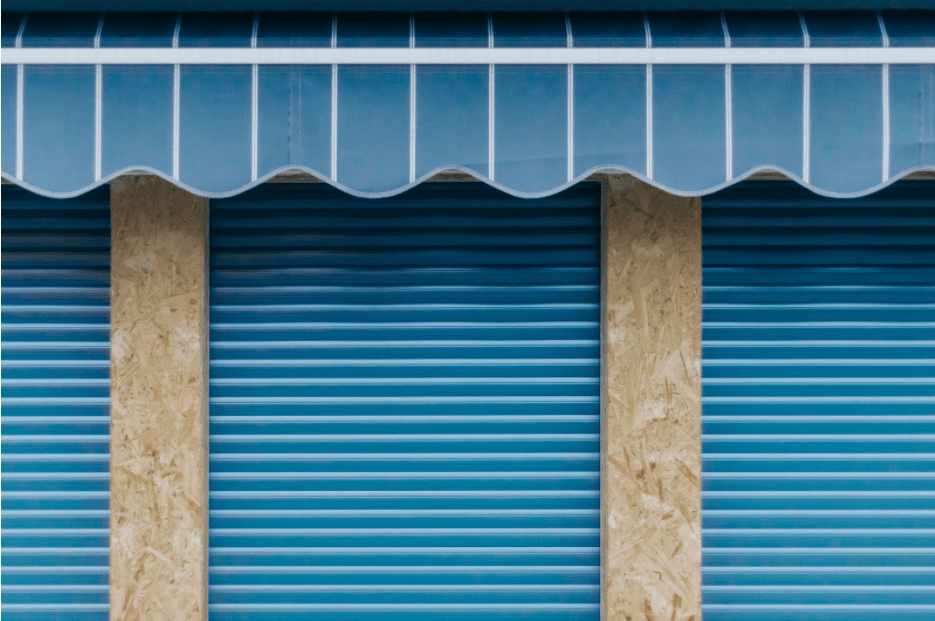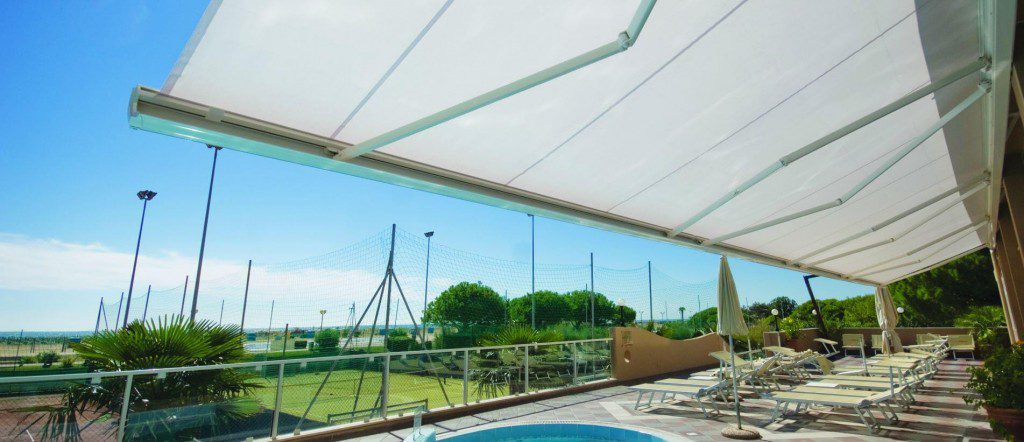The retractable awning is the perfect way to decorate your deck, for example, by providing the necessary shade during the summer days.

Definition of a retractable awning
The retractable awning is characterized by the fact that it can extend and retract according to weather conditions and your needs.
Parts of a retractable awning
I advise you to choose retractable awnings made of forged aluminum and not die-cast aluminum..Lateral articulated arms should contain German stainless steel chains, not cables, and heavy duty Italian springs . They are considered to be some of the highest quality awnings in the world. Most of them are motorized with remote control, which is a great convenience.
Another essential part of the awning is the fabric. The fabric should be be high quality, UV-resistant, solution dyed acrylic material and resistant to all conditions.
Retractable awning terms
Abrasion resistance
The ability of the material to withstand the wear and tear of friction, which is occasionally caused by the mechanical parts, as well as by repetitive scraping or rubbing.

Acrylic
A material that can be made in filament or staple forms. The fiber-forming substance is any long-chain synthetic polymer composed of at least 85% by weight of acrylonitrile units.
Adhesive/epoxy anchors
Attachments, which serve for fastening to a variety of base materials such as brick, marble, stone, concrete block (CMU) , etc.
Aluminum tubing
There are a wide variety of shapes, sizes, and tempers of aluminum tubing. Note that tubing measurements are described with outside dimensions.
Anchorage
That includes the strength, location, and type of connections between the retractable awning and the building or between the awning and the building’s foundations.
Appliqué
Ornamental design or motif in which pieces of fabric are sewn or stuck onto a more significant part to form a picture or pattern.
Basket weave
A plain weave with two or more interlaced warp and filling threads. In this way, it resembles a plaited basket. It is characterized by a flat look, porosity, and looseness.
Bias
It is a direction diagonal to the weave of a fabric. Usually, it is oriented at 45 degrees to the warp and fill directions.
Bolt-through
The bolt is an attachment that is used for wall-mounted installations and other structures. It passes through all the thicknesses or layers which it binds or in which it is fixed, and it is securely fastened with a nut.
Braid
That is a narrow fabric, which is most commonly used on the edge of a valance to finish the cut edge of the material.
Breaking strength
The ability of a material to withstand a pulling or tensile force. For a retractable awning, the breaking strength, also known as tensile strength, shows the measured load required to break the material under tension.

Calendering
A process in which cloth passes under carefully controlled heat and pressure procedures to produce various textures or fabric effects.
Canvas
A strong cloth made from cotton, linen, or synthetic with an even firm weave. In many cases, the awning stripe canvas has printed or woven stripes.
Coated fabric
A fabric that has undergone a coating procedure to hold the added properties and have more functions. For that purpose in the material, a liquid or semi-liquid polymer (PVC, acrylics, and urethanes) are applied in firmly adhering layers. For example, the cotton fabric becomes impermeable or water resistant.
Count
It includes two things:
- number size of yarn
- a number of ends and picks per inch of a weave
Crazing
Crazing specifies a fabric that has scratch marks on the surface. Such defects occur during abrasion or folding, but they do not affect the function or the fabric performance.
Crocking
In cases where there is an improper dye, fixation, or bad penetration, rubbing off of color is observed.
Cut-out lettering
Letters and graphic elements are cut from fabric and replaced by letters and details of another material.
De-Sizing
Remove original size from warp yarns.
Die Casting
A process in which parts are formed, such as force molten metal into metal molds. Zinc and aluminum are most commonly used for this purpose. It is possible for the castings to be made to very exacting tolerance. Not as strong as forging.
Di-electric welding
A process in which a high-frequency electric impulse is sent through the fabrics using a bar or table and mixes up the molecular structure of the thermoplastic materials.
Dimensional Stability
Each awning fabric can stretch and contract in the warp, fill, or bias directions. When stretching and contraction can be partially controlled, that is dimensional stability.
Drawing
Drawing has two primary meanings. First, it is a stretching of fibers to increase orientation and reducing the size. On the other hand, drawing is a process of repeated drafting of fiber slivers on a carding machine and doubling and redoubling the slivers.
Electrogalvanized or Electro Plated
A process in which metals are charged with positive ions and evenly put into a negative ion solution on the metal.
Expansion anchors
Attachments used for fastening awnings to concrete surfaces. They press hard against the side of the drilled hole, so the awning attaches firmly.
Extrusion Coated
Dry polymers are heated and mixed through an extruder. With the help of a roller or die, the polymers are pressed to be scattered on the frame.
Fiber
Includes various types of textiles, such as cotton, wool, and others. It also includes filament yarns, monofilaments, and tow.

Fire proofed
A fabric that is impervious to flame and it does not support it.
Fire retardant finish
A finish rendering a cloth that will repel a flame or will prevent the spreading of it. The test period is extended.
Fluoropolymer
A synthetic fiber, which is durable from the sunlight and ultra-violet deterioration.
Hand painting
A process in which details are hand-painted on the fabric.
Heat color-transfer
Process of adhering color to the fabric using heat and a vacuum applicator.
Hot-dip galvanized
Process of adding a protective coating to the metal. For this purpose, the metal is immersed in a hot solution of zinc.
Hydrostat pressure
Specify the ability of a fabric to resist water under pressure.
Jacquard Weave
Type of weave, which is observed in brocades, tapestries, and other complicated cloths.
Lag screw
The best option for fastening to wood framing. They are screws that are tapered to a point and do not utilize nuts.
Lateral arm awning
A retractable lateral arm awning uses spring loaded arms, is entirely supported from a structure and constructed so that the awning cover and supporting frame retract completely against the structures exterior wall, soffit/eave/overhang, fascia, beam or roof.
Load
Anything that causes a force on a structural member is a load.
It can be:
- dead loads – the self-weight of the retractable awning
- wind loads
- snow loads (retractable awnings are not designed for any amount of snow load)
- live loads – all changing loads
Mesh
Knitted or woven fiber with an open texture.
Mildew proof
Refers to fabrics, which are mildew resistant.
Modulus
A measure that indicates how a fabric reacts when tensioned and relaxed (wind and snow loads, elasticity, etc.)
Monofilament
A sole filament of manufactured fiber, used as yarn.
Natural fiber
Organic fibers as cotton, jute, etc.
Non-woven
A material made of fibers in a web or mat held together by a bonding agent. It is not spun, knitted, or woven.
Nylon
A high strength, resilient synthetic fiber, which contains the recurring amid group CONH.
Painted cloth
A cloth, finished by painting in solid colors or in assorted stripes.
Polyester
A synthetic fiber, which is not characterized by strength and resistance to ultraviolet deterioration.
Polymer
A synthetic material from which fibers are formed.
Ponding or pooling
Proper retractable awning pitch or angle must be placed on the arms, so the draining water from LIGHT rain cannot cause the fabric to sag, collect water on the surface and possibly collapse. Retractable awnings are not designed for HEAVY rain.
Pre-stress
The long-term stress for which a retractable awning is designed.
Seam
By welding, cementing, or sewing, where the fabric panels are joined.
Shear
A force that makes two contacting parts slide upon each other in opposite directions.
Stainless steel
A special steel alloy that has higher concentrations of chromium and nickel and if marine grade, will not corrode/rust.

Substrate
It is the surface to which an awning frame is attached.
Top coating
It is intended for the top, front, or side of the fabric.
Tow
An enormous group of continuous filaments, such as polyester, nylon, and others.
Ultimate strength
The degree of durability of retractable awning material at gradual and uniformly applied load.
UV resistance
Shows the endurance of exposure to sunlight.
Valance
A free-hanging removable piece of fabric that hangs off the front, moving bar of a retractable awning. It creates a decorative effect.
Warp yarns
They are yarns that run lengthwise and parallel to the salvage in the machine direction of a woven or warp knitted fabric.
Water repellent/water resistant finish
The ability of a fabric to resist water penetration and leakage.
Waterproof
It is applied to the fabric to make it impervious to penetration of water
Webbing
A sturdy fabric used for more strength.
